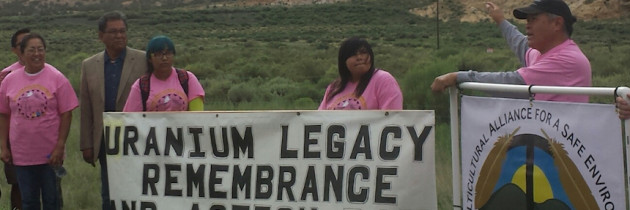Thousands of abandoned mines nationwide pose risk
September 15, 2015
By Kathy Helms
Cibola County Bureau
GRANTS – Four federal agencies have identified a total of more than 100,000 contaminated and potentially contaminated sites on lands they manage. But that is not even a complete inventory, in particular, for abandoned mines, a General Accountability Office official said Friday.
For Western states still reeling from the toxic Gold King Mine spill in Colorado, the specter of thousands of leaking abandoned mines and many more unaccounted for, is not reassuring.
The federal government owns over 700 million acres of land – primarily managed by the Departments of Agriculture, the Interior, Defense, and Energy. Some of the land is contaminated with hazardous waste from prior uses and poses environmental or human health risks, J. Alfredo Gomez, GAO’s director of Natural Resources and Environment, told a subcommittee of the House Committee on Energy and Commerce.
In some cases, the agencies do not have sufficient staff to conduct a complete inventory of contaminated sites, Gomez said.
The four departments stated that they are allocating and spending millions of dollars annually on environmental cleanup. Estimated future costs of cleanup are in the hundreds of billions of dollars.
Forest Service numbers
GAO reported in January that the USDA Forest Service had not developed a complete, consistent, or usable inventory of abandoned mines and had no plans and procedures to do so because, according to Forest Service officials, they did not have the resources. Without a comprehensive inventory, USDA and the Forest Service will not have reasonable assurance they are prioritizing and addressing the sites that pose the greatest risk, GAO stated.
The Forest Service estimated there are from 27,000 to 39,000 abandoned mines on their lands – approximately 20 percent of which may pose some level of risk to human health or the environment. Such risks may include chemicals and explosives, acid mine drainage, and heavy metal contamination in mine waste rock.
In fiscal year 2013, USDA allocated over $22 million to environmental cleanup efforts and reported in its financial statements $176 million in environmental liabilities to address 100 sites.
BLM inventory
GAO also stated in its January report that the Interior had identified 4,722 sites with confirmed or likely contamination. These included 4,098 Bureau of Land Management sites that the agency reported had confirmed contamination or required further investigation to determine whether remediation was warranted. The majority of these sites were abandoned mines.
BLM also identified over 30,000 abandoned mines that were not yet assessed for contamination.That number may actually be larger, GAO said, because BLM had not yet identified all of the abandoned mines on the land it oversees. BLM estimated it will take decades to complete the inventory.
Additionally, GAO found that the Interior’s Bureau of Indian Affairs, Bureau of Reclamation, Fish and Wildlife Service and National Park Service also have sites with environmental contamination.
In FY 2013, the Interior allocated about $13 million for environmental cleanup efforts and reported $192 million in environmental liabilities in its financial statements to address 434 sites.
Department of Defense
Before federal environmental legislation was enacted in the 1970s and 1980s regulating the generation, storage, treatment and disposal of hazardous waste, Defense activities and industrial facilities contaminated millions of acres of soil and water on and near Defense properties.
In June 2014, the Department of Defense reported to Congress that it had 38,804 contaminated sites in its inventory, including Base Realignment and Closure locations such as Fort Wingate, as well as munition response sites that were known or suspected to contain unexploded ordnance and discarded military munitions.
GAO reported in July 2010 that Defense spent almost $30 billion from 1986 to 2008 across all environmental cleanup and restoration activities at its installations. In its fiscal year 2014 agency financial report, Defense reported $58.6 billion in total environmental liabilities.
Department of Energy
Seventy years of nuclear weapons production and energy research by the Department of Energy and its predecessor agencies generated large amounts of radioactive waste, spent nuclear fuel, excess plutonium and uranium, contaminated soil and groundwater, and thousands of contaminated facilities.
DOE’s Office of Environmental Management is responsible for one of the world’s largest environmental cleanup programs.
According to DOE’s FY 2016 congressional budget request, Environmental Management has completed cleanup activities at 91 sites in 30 states and Puerto Rico, and has remaining cleanup responsibilities at 16 contaminated sites in 11 states. DOE reported receiving an annual appropriation of almost $5.9 billion in fiscal year 2015 to support cleanup activities. In 2014, the agency estimated its total liability for environmental cleanup at almost $300 billion.






